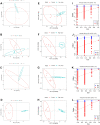Proteomics and Metabolomics Analysis Reveals the Toxicity of ZnO Quantum Dots on Human SMMC-7721 Cells
- PMID: 36683595
- PMCID: PMC9851061
- DOI: 10.2147/IJN.S389535
Proteomics and Metabolomics Analysis Reveals the Toxicity of ZnO Quantum Dots on Human SMMC-7721 Cells
Abstract
Purpose: ZnO quantum dots (QDs) are composed of less toxic metals than other QDs but have the same interesting photochemical properties. Thus, they have received considerable attention recently. Nevertheless, their toxicity cannot be ignored.
Methods: In this study, we incubated ZnO QDs with human SMMC-7721 cells for 24 h to assess their nanotoxicity through proteomics (Fold change >1.5 and p-value <0.05) and metabolomics (Fold change ≥ 1.5; VIP ≥ 1; p-value < 0.05) analyses.
Results: Both of 174 and 219 significantly changed metabolites were identified in human SMMC-7721 cells treated with 20 and 50 µg/mL ZnO QDs, respectively. ZnO QDs significantly modified metabolic pathways, including purine metabolism, ferroptosis, morphine addiction, alcoholism, cGMP-PKG signaling, and Cushing syndrome. Moreover, we identified 105 and 8 differentially expressed proteins in cells treated with 20 and 50 µg/mL ZnO QDs, and the pathways of alcoholism and Cushing syndrome were enriched.
Conclusion: ZnO QDs did not affect cell viability in a CCK8 assay, but disturbed the level of intracellular metabolites and proteins at 20 µg/mL. The KEGG analyses of the metabolomics and proteomics data both enriched the alcoholism and Cushing syndrome pathways. These results provide an experimental basis for future research on the safe use of nanomaterials.
Keywords: ZnO quantum dots; cytotoxicity; metabolomics; proteomics.
© 2023 Yang et al.
Conflict of interest statement
The authors report no conflicts of interest in this work.
Figures





Similar articles
-
Toxicity optimization of green zinc oxide quantum dots in zebrafish using Box-Behnken design: a novel approach for safer nanoparticle synthesis.Drug Chem Toxicol. 2025 Mar;48(2):367-380. doi: 10.1080/01480545.2024.2417960. Epub 2024 Oct 21. Drug Chem Toxicol. 2025. PMID: 39434256
-
Trace amounts of Cu²⁺ ions influence ROS production and cytotoxicity of ZnO quantum dots.J Hazard Mater. 2016 Mar 5;304:532-42. doi: 10.1016/j.jhazmat.2015.11.013. Epub 2015 Nov 15. J Hazard Mater. 2016. PMID: 26619052
-
The luminescent properties and toxicity controllability investigation of novel ZnO quantum dots with Schiff base complexes modification.J Nanosci Nanotechnol. 2014 May;14(5):3299-304. doi: 10.1166/jnn.2014.7990. J Nanosci Nanotechnol. 2014. PMID: 24734544
-
Progress on the toxicity of quantum dots to model organism-zebrafish.J Appl Toxicol. 2023 Jan;43(1):89-106. doi: 10.1002/jat.4333. Epub 2022 May 5. J Appl Toxicol. 2023. PMID: 35441386 Review.
-
An update on the biological effects of quantum dots: From environmental fate to risk assessment based on multiple biological models.Sci Total Environ. 2023 Jun 25;879:163166. doi: 10.1016/j.scitotenv.2023.163166. Epub 2023 Apr 1. Sci Total Environ. 2023. PMID: 37011691 Review.
Cited by
-
Cytotoxic Potencies of Zinc Oxide Nanoforms in A549 and J774 Cells.Nanomaterials (Basel). 2024 Oct 3;14(19):1601. doi: 10.3390/nano14191601. Nanomaterials (Basel). 2024. PMID: 39404328 Free PMC article.
-
Adverse Responses following Exposure to Subtoxic Concentrations of Zinc Oxide and Nickle Oxide Nanoparticles in the Raw 264.7 Cells.Toxics. 2023 Aug 6;11(8):674. doi: 10.3390/toxics11080674. Toxics. 2023. PMID: 37624179 Free PMC article.
References
MeSH terms
Substances
LinkOut - more resources
Full Text Sources

